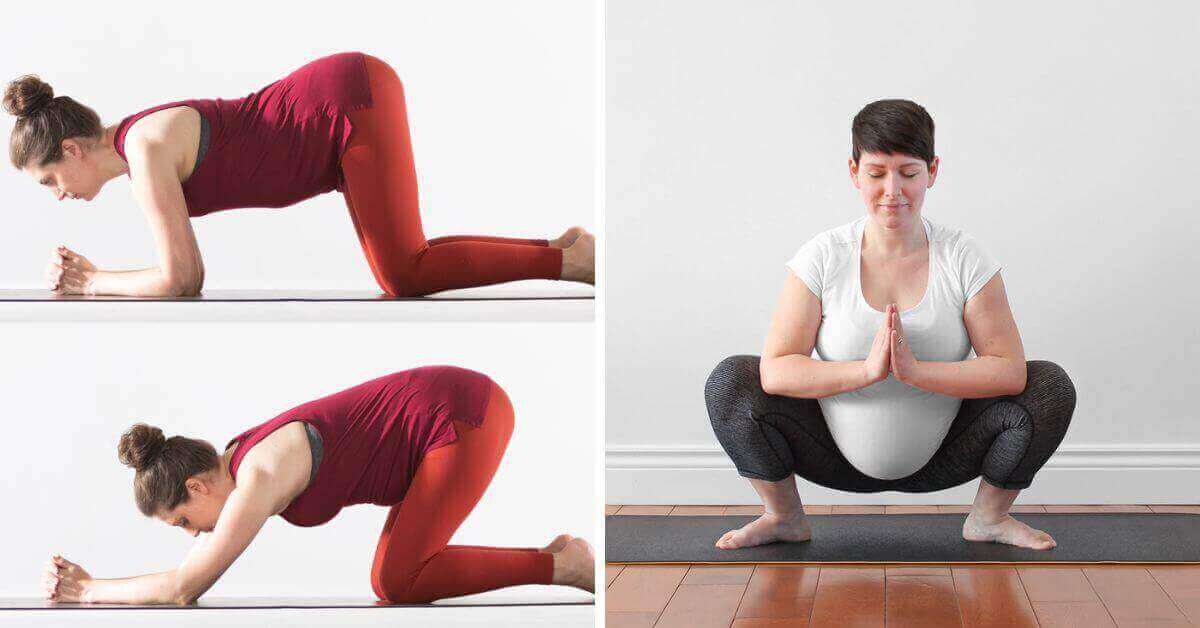Embracing the Final Stretch of Pregnancy with Yoga
The third trimester of pregnancy is a time of immense change, anticipation, and preparation. As the body adapts to support the growing baby, many expectant mothers experience physical discomfort, fatigue, and emotional shifts. Yoga for third trimester pregnancy offers a safe, gentle, and effective way to alleviate aches, enhance flexibility, and prepare for labor.
Practicing yoga in these final months helps relieve back pain, improve circulation, and strengthen the pelvic floor key factors for a smoother birth experience. It also fosters mental relaxation, reducing stress and promoting deeper connection with the baby. With proper modifications, yoga remains a powerful tool to ease the challenges of late pregnancy while supporting overall well-being.
In this guide, we’ll explore the benefits of yoga during the third trimester, essential safety tips, and the best poses to help expecting mothers stay strong, calm, and prepared for childbirth.
Benefits of Yoga in the Third Trimester
Yoga for third trimester pregnancy offers a holistic approach to maintaining physical comfort, emotional balance, and mental resilience as you prepare for childbirth. The practice is not just about movement it enhances circulation, strengthens the pelvic floor, and creates a sense of relaxation during this transformative stage. Let’s explore the key benefits in detail.
1. Relieves Back and Hip Pain
As the baby grows, the extra weight shifts your center of gravity, causing increased strain on the lower back, hips, and pelvis. This can lead to discomfort, muscle tightness, and even sciatica pain. Practicing gentle yoga poses like Cat-Cow Stretch, Child’s Pose, and Supported Bridge Pose helps relieve tension, improve spinal alignment, and reduce lower back strain.
Strengthening the core and hip muscles through modified yoga movements can provide better support to the spine, preventing further discomfort.
2. Improves Circulation and Reduces Swelling
Swelling in the feet, ankles, and legs is a common third-trimester complaint due to increased fluid retention and reduced circulation. When blood and lymphatic fluids do not move efficiently, the buildup can cause discomfort.
Yoga poses such as Legs-Up-The-Wall Pose (Viparita Karani), Seated Forward Bend, and Gentle Twists encourage healthy blood flow, reducing swelling and promoting oxygen delivery to the baby. Controlled deep breathing (pranayama) further enhances circulation, supporting both maternal and fetal health.
3. Strengthens the Pelvic Floor
A strong pelvic floor is crucial for supporting the uterus and preparing for childbirth. Yoga incorporates exercises that gently engage and strengthen these muscles, improving bladder control, reducing the risk of incontinence, and making the birthing process smoother.
Poses like Malasana (Yogi Squat), Butterfly Pose (Baddha Konasana), and Bridge Pose help tone the pelvic floor muscles while maintaining flexibility. Engaging in gentle Kegel exercises during yoga sessions can also provide additional pelvic support.
4. Enhances Emotional Well-Being and Reduces Stress
Pregnancy comes with a whirlwind of emotions excitement, anxiety, anticipation, and sometimes even fear. The hormonal shifts in the third trimester can make these feelings even more intense. Yoga integrates mindfulness, deep breathing, and meditation, which help regulate cortisol levels (the stress hormone), calming the nervous system.
Alternate Nostril Breathing (Nadi Shodhana), Guided Meditation, and Gentle Flow Yoga Sequences help cultivate inner peace, balance emotions, and foster a deeper connection between mother and baby.
5. Promotes Better Sleep and Reduces Fatigue
Sleep disturbances become more frequent in the third trimester due to physical discomfort, frequent urination, and hormonal fluctuations. Poor sleep can lead to increased fatigue, irritability, and lower immunity. Yoga helps regulate the body’s natural relaxation response by reducing muscle tension and calming the mind.
Side-Lying Savasana, Reclining Butterfly Pose, and Supported Forward Fold promote relaxation, making it easier to fall asleep and stay asleep longer. Practicing yoga in the evening, along with breathing exercises, can significantly improve sleep quality.
6. Encourages Optimal Fetal Positioning for Labor
As the due date approaches, the baby’s positioning becomes critical for a smooth delivery. Ideally, the baby should be in a head-down, anterior position for an easier birth. Yoga poses such as Pelvic Tilts, Forward-Leaning Inversions, and Supported Malasana create more space in the pelvis, allowing the baby to move into an optimal position. Regular practice of these poses can reduce the chances of breech presentation and encourage an easier labor experience.
By incorporating yoga into your third-trimester routine, you can experience enhanced comfort, reduced stress, and a deeper sense of well-being. The physical, emotional, and mental benefits of yoga prepare your body and mind for the journey of labor and childbirth, making it an invaluable tool for expectant mothers.

Safety Tips for Practicing Yoga in the Third Trimester
Practicing yoga in the third trimester is beneficial, but safety is key to avoiding strain and ensuring a positive experience. Follow these essential guidelines for a safe and effective yoga practice.
- Listen to Your Body – Avoid pushing yourself into discomfort. If a pose feels painful or causes strain, modify or skip it.
- Avoid Deep Twists and Backbends – Twisting intensely can put pressure on the abdomen, while deep backbends may overstretch ligaments. Opt for open twists and gentle spinal movements instead.
- Use Props for Support – Bolsters, pillows, and yoga blocks help maintain stability and comfort, especially in balancing and seated poses.
- Avoid Lying on Your Back for Long Periods – This can reduce circulation to the baby. Instead, practice poses on your side or in a supported reclined position.
- Modify Balance Poses – Due to a shifting center of gravity, always practice near a wall or use a chair for extra stability.
- Focus on Breath Control – Deep breathing (pranayama) helps regulate emotions, increase oxygen flow, and prepare for labor.
- Stay Hydrated and Avoid Overheating – Drink plenty of water and practice in a cool, well-ventilated space to prevent dizziness or fatigue.
By following these precautions, yoga remains a safe, empowering practice throughout the third trimester.
Best Yoga Poses for the Third Trimester
Yoga for third trimester pregnancy should focus on gentle, supportive, and effective poses that enhance flexibility, relieve discomfort, and prepare the body for labor. Below are some of the best prenatal yoga poses for the final months of pregnancy.
1. Cat-Cow Pose (Marjaryasana-Bitilasana)
This gentle spinal movement helps alleviate back pain, improves flexibility, and encourages the baby into an optimal birthing position. Move slowly between arching (Cow) and rounding (Cat) while synchronizing breath.
✔ Relieves lower back tension
✔ Encourages fetal positioning
✔ Improves spinal flexibility
2. Malasana (Yogi Squat)
A powerful pose for opening the hips and strengthening the pelvic floor, Malasana encourages better fetal positioning and enhances flexibility in the lower body. Use a yoga block under your hips if needed for extra support.
✔ Opens hips and strengthens pelvic muscles
✔ Prepares the body for labor
✔ Supports lower body flexibility
3. Child’s Pose (Balasana) with Wide Knees
This restorative pose helps relieve lower back tension, opens the hips gently, and encourages relaxation. Keep knees wide to accommodate the belly and extend arms forward for a deep stretch.
✔ Relieves back and hip discomfort
✔ Reduces stress and tension
✔ Encourages deep breathing
4. Butterfly Pose (Baddha Konasana)
Sitting with the soles of the feet together and knees dropped outward stretches the inner thighs and hips. This pose helps improve circulation and prepares the pelvis for labor.
✔ Increases flexibility in the pelvic area
✔ Improves blood circulation
✔ Prepares the body for childbirth
5. Side-Lying Savasana
Traditional Savasana (lying on the back) is not recommended in the third trimester. Instead, rest on your side with a pillow between the knees for deep relaxation and improved circulation.
✔ Prevents pressure on major blood vessels
✔ Enhances relaxation and rest
✔ Supports better sleep quality
6. Supported Bridge Pose
Using a yoga block under the lower back provides gentle support while stretching the hips and strengthening the pelvic floor. Avoid lifting too high to prevent strain.
✔ Strengthens pelvic muscles
✔ Reduces lower back tension
✔ Enhances stability and circulation
Practicing these poses with mindfulness and proper breathing will enhance comfort, reduce stress, and prepare both body and mind for a smooth labor experience.

Breathing Techniques (Pranayama) for Labor Preparation
Practicing breathing techniques during pregnancy helps expecting mothers stay calm, manage pain, and conserve energy during labor. Controlled breathing enhances oxygen flow, reduces tension, and promotes relaxation.
Here are some effective pranayama techniques for labor preparation:
1. Deep Belly Breathing (Diaphragmatic Breathing)
This technique involves inhaling deeply through the nose, expanding the belly, and exhaling slowly through the mouth. It helps reduce stress, control heart rate, and improve oxygen supply to the baby.
✔ Promotes relaxation and reduces anxiety
✔ Enhances oxygen flow for mother and baby
✔ Helps maintain focus during contractions
2. Ujjayi Breathing (Ocean Breath)
A slow, controlled breath with a slight constriction in the throat, creating a gentle ocean-like sound. This method helps regulate contractions and maintain a steady rhythm during labor.
✔ Keeps breathing steady and controlled
✔ Prevents hyperventilation and tension
✔ Helps manage pain and discomfort
3. Alternate Nostril Breathing (Nadi Shodhana)
This technique involves alternating breaths between nostrils, balancing the nervous system and promoting mental clarity.
✔ Reduces stress and emotional tension
✔ Enhances focus and mindfulness
✔ Helps maintain a sense of calm before and during labor
Practicing these breathing techniques regularly can make labor more manageable, promoting a smoother and more positive birthing experience.
FAQs:
Is it safe to practice yoga in the third trimester?
Yes, yoga is safe during the third trimester when practiced mindfully. Focus on gentle stretches, breathing exercises, and supported poses while avoiding deep twists, intense backbends, and lying on your back for extended periods. Always consult your healthcare provider before starting any exercise routine.
Which yoga poses should be avoided in the third trimester?
Avoid deep backbends, closed twists, inversions, poses that put pressure on the belly, and any position that requires lying flat on your back. Also, stay away from strenuous balancing poses unless supported by a wall or chair.
Can yoga help with labor pain and delivery?
Yes, prenatal yoga strengthens the pelvic floor, improves flexibility, and promotes deep breathing techniques that help manage labor pain. Certain poses encourage optimal fetal positioning, making delivery smoother.
How often should I practice yoga in the third trimester?
Practicing yoga 3–5 times a week for 20–30 minutes can be beneficial. Listen to your body and rest when needed. Even short, gentle sessions can provide significant relief.
Are breathing techniques useful for labor?
Absolutely! Deep belly breathing, Ujjayi breath, and alternate nostril breathing help control pain, reduce stress, and maintain a calm mindset during labor and delivery.
Can I start yoga in the third trimester if I haven’t done it before?
Yes, but start with gentle, beginner-friendly prenatal yoga under the guidance of a certified instructor. Avoid strenuous poses and focus on relaxation, stretching, and breathwork.







